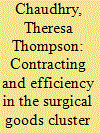| Srl | Item |
| 1 |
ID:
103948


|
|
|
|
|
| Publication |
2011.
|
| Summary/Abstract |
This article provides empirical evidence of the inefficiency of contracting institutions (measured by high switching costs) among surgical instrument producers in Sialkot, Pakistan, even though it is an industrial cluster where manufacturers have access to a multiplicity of suppliers. Following the methodology of Johnson, McMillan and Woodruff (2002), we found that nearly 50 per cent of firms in the sample would reject an untried supplier offering a lower price. The decision to reject a prospective new supplier offering a 10 per cent discount was positively related to the complexity of the input and measures of relational contracting, and negatively related to a belief in informal contract enforcement mechanisms. Firms were more likely to switch to the prospective discount supplier when they were introduced through a business network. Belief in formal contract enforcement was not significant in any of the regressions.
|
|
|
|
|
|
|
|
|
|
|
|
|
|
|
|
| 2 |
ID:
183145


|
|
|
|
|
| Summary/Abstract |
Multinational military exercises are among the most notable demonstrations of military cooperation and intent. On average, one is initiated every 8.9 days. But it has often been argued that joint military exercises (JMEs) increase the risk of war. Using a relational contracting approach, we claim that formal military alliances mediate the effect of JMEs. Exercises and alliances serve complementary functions: The former allows targeted responses to military provocations by adversaries, while the latter provides institutional constraints on partners and establishes a partnership’s overall strategic limitations. In combination, alliances dampen the conflict escalation effects of exercises, deterring adversaries while simultaneously restraining partners. We test this theory using a two-stage model on directed dyadic data of JMEs from 1973 through 2003. We find that JMEs in general do not escalate conflict, and that JMEs conducted with allies in particular reduce the probability of conflict escalation.
|
|
|
|
|
|
|
|
|
|
|
|
|
|
|
|
| 3 |
ID:
116341


|
|
|
|
|
| Publication |
2012.
|
| Summary/Abstract |
How does the way in which a group organizes change the lethality of the group's attacks? In this article, we argue that groups organized vertically as hierarchies are likely to conduct more lethal attacks. We build our argument around three advantages inherent to centralized structures: functional differentiation, clear command and control structures, and accountability. We argue that each of these characteristics positively impacts an organization's ability to deliver an effective lethal blow. To test our argument, we use a mixed method approach, drawing on empirical evidence and support from a time-series case study. Our large-N analysis examines the trends in more than 19,000 attacks. In this test we develop a novel proxy measure for hierarchy based on a group's bases of operation and non-violent activities. To complement the empirical work, we examine the history of Euskadi Ta Askatasuna (ETA), the Basque separatist group. Over several decades of violent operations, this group's structure has changed dramatically. We analyze how these shifts impacted ETA's ability to maximize the effectiveness and damage of their attacks. In both the case study and large-N analysis, the more hierarchically organized the group, the more easily the group can orchestrate lethal attacks.
|
|
|
|
|
|
|
|
|
|
|
|
|
|
|
|